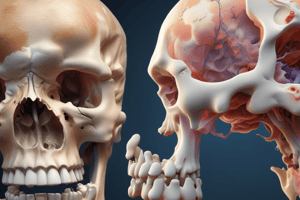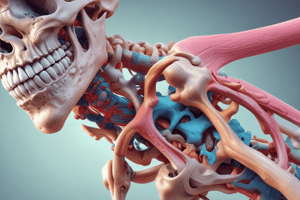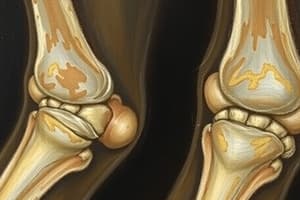Podcast
Questions and Answers
Which of the following is a characteristic feature of osteoporosis?
Which of the following is a characteristic feature of osteoporosis?
- Increased calcium levels in bones
- Decreased bone mass and deterioration of bone tissue (correct)
- Increased osteoblast activity
- Increased bone density
A patient is diagnosed with osteoporosis. Which diagnostic test is considered the gold standard for diagnosing this condition?
A patient is diagnosed with osteoporosis. Which diagnostic test is considered the gold standard for diagnosing this condition?
- MRI
- Dual-energy X-ray absorptiometry (DEXA) (correct)
- CT scan
- X-ray
Which of the following are risk factors for osteoporosis? (Select All That Apply)
Which of the following are risk factors for osteoporosis? (Select All That Apply)
- Long-term corticosteroid use (correct)
- High calcium intake
- Postmenopausal status (correct)
- Sedentary lifestyle (correct)
- Smoking (correct)
Which medication is commonly prescribed for osteoporosis treatment?
Which medication is commonly prescribed for osteoporosis treatment?
Which symptom is most characteristic of osteoarthritis?
Which symptom is most characteristic of osteoarthritis?
Which findings are expected in a patient with osteoarthritis? (Select All That Apply)
Which findings are expected in a patient with osteoarthritis? (Select All That Apply)
What is the primary goal of total knee arthroplasty (TKA)?
What is the primary goal of total knee arthroplasty (TKA)?
Which feature differentiates rheumatoid arthritis (RA) from osteoarthritis (OA)?
Which feature differentiates rheumatoid arthritis (RA) from osteoarthritis (OA)?
Which medications are used to treat rheumatoid arthritis (RA)? (Select All That Apply)
Which medications are used to treat rheumatoid arthritis (RA)? (Select All That Apply)
What are early symptoms of rheumatoid arthritis (RA)?
What are early symptoms of rheumatoid arthritis (RA)?
What is the priority assessment in a patient with a femur fracture?
What is the priority assessment in a patient with a femur fracture?
Which complication is most concerning with a long bone fracture?
Which complication is most concerning with a long bone fracture?
Which are signs of compartment syndrome? (Select All That Apply)
Which are signs of compartment syndrome? (Select All That Apply)
Which intervention is essential after a laminectomy?
Which intervention is essential after a laminectomy?
What is the primary goal of laminectomy surgery?
What is the primary goal of laminectomy surgery?
Which is a major post-amputation complication?
Which is a major post-amputation complication?
What is an important nursing intervention for a patient with a new prosthesis?
What is an important nursing intervention for a patient with a new prosthesis?
What is the primary cause of gout?
What is the primary cause of gout?
Which food should a patient with gout avoid?
Which food should a patient with gout avoid?
Which are clinical signs of acute gout? (Select All That Apply)
Which are clinical signs of acute gout? (Select All That Apply)
A patient with a closed femur fracture is placed in traction. What is the nurse's priority action?
A patient with a closed femur fracture is placed in traction. What is the nurse's priority action?
A patient with a cast reports severe pain unrelieved by medication. What is the nurse's next action?
A patient with a cast reports severe pain unrelieved by medication. What is the nurse's next action?
Which intervention is essential for a patient with an external fixation device?
Which intervention is essential for a patient with an external fixation device?
Which of the following are complications of fractures? (Select All That Apply)
Which of the following are complications of fractures? (Select All That Apply)
A patient with a hip fracture is scheduled for surgery. What is the priority nursing intervention preoperatively?
A patient with a hip fracture is scheduled for surgery. What is the priority nursing intervention preoperatively?
A patient is post-op from a total hip replacement (THR). What movement should they avoid?
A patient is post-op from a total hip replacement (THR). What movement should they avoid?
Which of the following are essential post-op interventions for a total knee replacement (TKR)? (Select All That Apply)
Which of the following are essential post-op interventions for a total knee replacement (TKR)? (Select All That Apply)
Which complication should the nurse monitor for in a post-op total hip replacement patient?
Which complication should the nurse monitor for in a post-op total hip replacement patient?
A patient post-TKR asks why they need to wear sequential compression devices (SCDs). The nurse's best response is:
A patient post-TKR asks why they need to wear sequential compression devices (SCDs). The nurse's best response is:
Which patient statement indicates a need for further teaching after a laminectomy?
Which patient statement indicates a need for further teaching after a laminectomy?
A patient post-laminectomy reports new onset numbness in their leg. What is the nurse's priority action?
A patient post-laminectomy reports new onset numbness in their leg. What is the nurse's priority action?
Which intervention is important for a post-op laminectomy patient? (Select All That Apply)
Which intervention is important for a post-op laminectomy patient? (Select All That Apply)
Which statement by a patient post-amputation requires further teaching?
Which statement by a patient post-amputation requires further teaching?
Which interventions should be included in the care of a patient with a new lower limb prosthesis? (Select All That Apply)
Which interventions should be included in the care of a patient with a new lower limb prosthesis? (Select All That Apply)
Which dietary instruction should be given to a patient with gout?
Which dietary instruction should be given to a patient with gout?
Which medications are used for acute gout attacks? (Select All That Apply)
Which medications are used for acute gout attacks? (Select All That Apply)
Which statement indicates understanding of gout management?
Which statement indicates understanding of gout management?
Which intervention helps prevent osteoporosis?
Which intervention helps prevent osteoporosis?
What is the primary treatment goal for osteoarthritis?
What is the primary treatment goal for osteoarthritis?
Which of the following patients is at highest risk for developing a fat embolism?
Which of the following patients is at highest risk for developing a fat embolism?
Which of the following is a sign of a fat embolism?
Which of the following is a sign of a fat embolism?
A patient with osteoarthritis asks about non-pharmacologic pain relief strategies. Which intervention should the nurse recommend?
A patient with osteoarthritis asks about non-pharmacologic pain relief strategies. Which intervention should the nurse recommend?
Which statement by a patient with rheumatoid arthritis (RA) indicates they need more teaching?
Which statement by a patient with rheumatoid arthritis (RA) indicates they need more teaching?
A patient is diagnosed with chronic tophaceous gout. What complications should the nurse assess for? (Select All That Apply)
A patient is diagnosed with chronic tophaceous gout. What complications should the nurse assess for? (Select All That Apply)
A patient with a below-knee amputation is experiencing phantom limb pain. Which intervention is most appropriate?
A patient with a below-knee amputation is experiencing phantom limb pain. Which intervention is most appropriate?
Flashcards
Osteoporosis
Osteoporosis
Decreased bone mass causing fragile bones.
DEXA scan
DEXA scan
Gold standard test for diagnosing osteoporosis.
Osteoporosis risk factors
Osteoporosis risk factors
Menopause, inactivity, smoking, and steroids.
Alendronate
Alendronate
Signup and view all the flashcards
Osteoarthritis (OA)
Osteoarthritis (OA)
Signup and view all the flashcards
Heberden's & Bouchard's nodes
Heberden's & Bouchard's nodes
Signup and view all the flashcards
Crepitus
Crepitus
Signup and view all the flashcards
Total Knee Arthroplasty (TKA) goal
Total Knee Arthroplasty (TKA) goal
Signup and view all the flashcards
Rheumatoid Arthritis (RA)
Rheumatoid Arthritis (RA)
Signup and view all the flashcards
Early RA symptoms
Early RA symptoms
Signup and view all the flashcards
Priority assessment: femur fracture
Priority assessment: femur fracture
Signup and view all the flashcards
Fat embolism
Fat embolism
Signup and view all the flashcards
Compartment syndrome signs
Compartment syndrome signs
Signup and view all the flashcards
Logrolling
Logrolling
Signup and view all the flashcards
Laminectomy goal
Laminectomy goal
Signup and view all the flashcards
Phantom limb pain
Phantom limb pain
Signup and view all the flashcards
Prosthesis Skin Care
Prosthesis Skin Care
Signup and view all the flashcards
Primary cause of gout
Primary cause of gout
Signup and view all the flashcards
Foods to avoid with gout
Foods to avoid with gout
Signup and view all the flashcards
Traction priority
Traction priority
Signup and view all the flashcards
Severe unrelieved pain with a cast
Severe unrelieved pain with a cast
Signup and view all the flashcards
Pin care
Pin care
Signup and view all the flashcards
Pre-op hip fracture priority
Pre-op hip fracture priority
Signup and view all the flashcards
Movement to avoid post-THR
Movement to avoid post-THR
Signup and view all the flashcards
Essential post-TKR
Essential post-TKR
Signup and view all the flashcards
Post-op THR complication
Post-op THR complication
Signup and view all the flashcards
Why use SCDs?
Why use SCDs?
Signup and view all the flashcards
Post-Laminectomy teaching
Post-Laminectomy teaching
Signup and view all the flashcards
New onset numbness post-laminectomy
New onset numbness post-laminectomy
Signup and view all the flashcards
Dietary instruction for gout
Dietary instruction for gout
Signup and view all the flashcards
Study Notes
Osteoporosis
- Osteoporosis is characterized by excessive bone resorption, leading to fragile bones
- Decreased bone mass and deterioration of bone tissue are characteristic features of osteoporosis
- Dual-energy X-ray absorptiometry (DEXA) measures bone mineral density and is the best tool for diagnosing osteoporosis
- Risk factors include hormonal changes, inactivity, smoking, and corticosteroid use
- Alendronate is a bisphosphonate that reduces bone resorption and is commonly prescribed for osteoporosis treatment
Osteoarthritis (OA)
- Pain that worsens with activity and improves with rest is most characteristic of osteoarthritis
- Osteoarthritis is degenerative, unlike rheumatoid arthritis which involves systemic inflammation
- Heberden's nodes, Bouchard's nodes, and crepitus are expected findings in a patient with osteoarthritis
- The primary goal of total knee arthroplasty (TKA) is to relieve pain and restore joint function
- TKA replaces damaged joints to restore mobility and reduce pain
Rheumatoid Arthritis (RA)
- The presence of systemic inflammation differentiates RA from OA
- RA is autoimmune and affects multiple joints systemically
- Methotrexate, NSAIDs, corticosteroids, and hydroxychloroquine are medications used to treat RA
- These drugs help manage inflammation and disease progression
- Warm, swollen joints with morning stiffness are early symptoms of RA
- These early signs differentiate RA from other joint disorders
Fractures
- Capillary refill and pulses are the priority assessment in a patient with a femur fracture
- Neurovascular checks ensure blood supply is intact
- Fat embolism is the most concerning complication with a long bone fracture
- Fat embolism syndrome can be fatal and occurs in long bone fractures
- Severe pain unrelieved by medication, pallor, pulselessness, and decreased sensation are signs of compartment syndrome
- These signs are the classic “6 P’s” of compartment syndrome
- Logrolling the patient is an essential intervention after a laminectomy
- Logrolling maintains spinal alignment and prevents injury
- The primary goal of laminectomy surgery is to relieve pressure on spinal nerves
- Laminectomy decompresses the spinal cord to relieve pain
Amputations
- Phantom limb pain is a major post-amputation complication and is a common post-amputation experience
- Teaching proper skincare is an important nursing intervention for a patient with a new prosthesis
- This intervention prevents infection and irritation at the prosthesis site
Gout
- Increased uric acid levels are the primary cause of gout
- Uric acid crystal deposits in joints trigger inflammation
- A patient with gout should avoid red meat
- Purine-rich foods (red meat, alcohol) increase uric acid
- Red, swollen joints and pain in the big toe are clinical signs of acute gout
- Gout commonly affects the big toe and causes swelling and joint damage
Fractures (Continued)
- Ensure the weights hang freely is the nurse’s priority action for a patient with a closed femur fracture placed in traction
- Traction must remain in place and uninterrupted to maintain bone alignment
- Notify the healthcare provider immediately is the nurse’s next action when a patient with a cast reports severe pain unrelieved by medication
- Severe pain unrelieved by medication is a sign of compartment syndrome, a medical emergency
- Perform frequent pin care is essential for a patient with an external fixation device
- Proper pin care prevents infection at the insertion site
- Fat embolism, osteomyelitis, and compartment syndrome are complications of fractures
- Fractures can lead to fat embolism, bone infection (osteomyelitis), and compartment syndrome
Pre-Operative Care
- Maintain proper alignment of the leg is the priority nursing intervention preoperatively for a patient with a hip fracture
- Proper alignment prevents further injury before surgery
Post Op: Care Total Knee & Hip Replacement
- Hip flexion greater than 90 degrees should be avoided in a patient post-op from a total hip replacement (THR)
- Excessive hip flexion can cause dislocation post-surgery
- The use of a continuous passive motion (CPM) machine, early ambulation, and regular use of anticoagulants are essential post-op interventions for a total knee replacement (TKR)
- CPM machines improve mobility, early ambulation prevents complications, and anticoagulants reduce clot risk
- Deep vein thrombosis is a complication the nurse should monitor for in a post-op total hip replacement patient
- Immobility increases the risk of clot formation post-op
- Sequential compression devices (SCDs) helps prevent blood clots for TKR patients
- SCDs promote venous return and reduce the risk of DVTs
Back Problems & Laminectomy
- The patient statement indicating a need for further teaching after a laminectomy is, "I can drive myself home tomorrow."
- Driving should be avoided immediately post-surgery
- Notify the healthcare provider is the nurse's priority action when a patient post-laminectomy reports new onset numbness in their leg
- Numbness may indicate nerve compression or damage
- Monitoring for urinary retention, logrolling the patient when repositioning, and assessing for signs of infection are interventions important for a post-op laminectomy patient
- Urinary retention, spinal misalignment, and infection are key post-op concerns
Amputations & Prosthesis Care
- The statement by a patient post-amputation requiring further teaching is, "I should elevate my stump continuously to prevent swelling."
- Continuous elevation can cause contractures
- Gradual weight-bearing, inspecting the residual limb daily, avoiding lotion on the residual limb, and wearing a prosthetic sock are interventions that should be included in the care of a patient with a new lower limb prosthesis
- Proper skin care and gradual adaptation to the prosthesis are important
Gout Management
- A patient with gout should limit purine-rich foods in their diet
- Purine-rich foods increase uric acid levels, worsening gout
- Colchicine and NSAIDs are medications used for acute gout attacks
- These medications reduce inflammation during acute attacks
- “I will drink plenty of fluids to help eliminate uric acid,” indicates an understanding of gout management
- Hydration prevents uric acid crystal formation
Final Questions: General Musculoskeletal Concepts
- Increased intake of calcium and Vitamin D helps prevent osteoporosis
- Calcium and Vitamin D maintain bone health
- Reducing joint pain and improve function is the primary treatment goal for osteoarthritis
- Osteoarthritis management focuses on symptom control
Fracture Complications & Post-Operative Care
- A 30-year-old patient with a femur fracture is at highest risk for developing a fat embolism
- Fat embolism syndrome is most commonly associated with long bone fractures, particularly the femur
- Sudden confusion and petechiae on the chest indicates a fat embolism
- Fat embolism syndrome can cause neurological impairment, petechiae, and respiratory distress
Osteoarthritis & Rheumatoid Arthritis
- Using heat therapy to relax stiff joints and applying cold packs before exercise can provide non-pharmacologic pain relief for clients with osteoarthritis
- Heat therapy can improve blood flow and relieve joint stiffness in OA
- Applying cold packs before exercise can help reduce inflammation and numb pain
- The patient statement indicating a need for more teaching is, "I should take my methotrexate only when I feel symptoms."
- Methotrexate should be taken regularly, even when symptoms improve, to prevent disease progression
Gout & Amputation Care
- Joint deformities and kidney stones are complications to assess for in a patient diagnosed with chronic tophaceous gout
- Tophaceous gout leads to joint damage and increases the risk of kidney stones due to uric acid accumulation
- Administering prescribed gabapentin is most appropriate for a patient with a below-knee amputation experiencing phantom limb pain
- Gabapentin (Neurontin) is effective in treating neuropathic pain, including phantom limb pain
Studying That Suits You
Use AI to generate personalized quizzes and flashcards to suit your learning preferences.
Related Documents
Description
Overview of osteoporosis and osteoarthritis (OA). Osteoporosis involves excessive bone resorption, leading to fragile bones. Osteoarthritis is a degenerative condition characterized by pain that worsens with activity and improves with rest.





